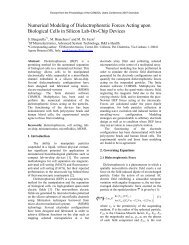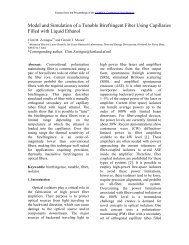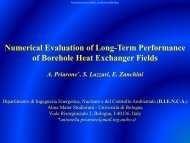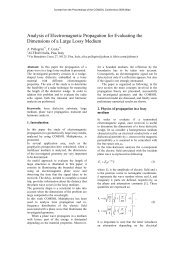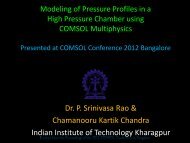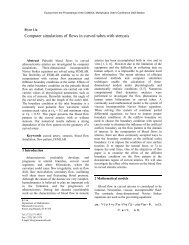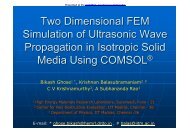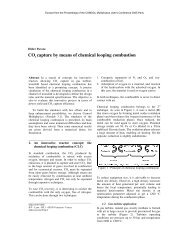Effect of Surface Structure on Liquid Wettability at ... - COMSOL.com
Effect of Surface Structure on Liquid Wettability at ... - COMSOL.com
Effect of Surface Structure on Liquid Wettability at ... - COMSOL.com
Create successful ePaper yourself
Turn your PDF publications into a flip-book with our unique Google optimized e-Paper software.
Presented <strong>at</strong> the <strong>COMSOL</strong> C<strong>on</strong>ference 2009 Bost<strong>on</strong>MODELING CONTACT LINE DYNAMICSIN EVAPORATING MENISCIJ. L. Plawsky, A. Ch<strong>at</strong>terjee, and P. C. Wayner, Jr.Department <str<strong>on</strong>g>of</str<strong>on</strong>g> Chemical and Biological Engineering,Rensselaer Polytechnic Institute, Troy, NY-12180<strong>COMSOL</strong> User's C<strong>on</strong>ference, Bost<strong>on</strong> 1
Introducti<strong>on</strong>: Phase Change He<strong>at</strong> TransferThe efficient acquisiti<strong>on</strong> and rejecti<strong>on</strong> <str<strong>on</strong>g>of</str<strong>on</strong>g> he<strong>at</strong> <strong>at</strong> very high he<strong>at</strong> fluxes (kW/cm 2 )requires synergistic advances in he<strong>at</strong> transfer m<strong>at</strong>erials, he<strong>at</strong> transfer surfaces, andhe<strong>at</strong> transfer devicesElectr<strong>on</strong>ics coolingPhot<strong>on</strong>ics coolingSpace & Avi<strong>at</strong>i<strong>on</strong>Solar EnergyVarious other applic<strong>at</strong>i<strong>on</strong>s include:Co<strong>at</strong>ing, Pl<strong>at</strong>ing, Cooling, Separ<strong>at</strong>i<strong>on</strong> and Reacti<strong>on</strong>, Adhesi<strong>on</strong>, Boiling andC<strong>on</strong>dens<strong>at</strong>i<strong>on</strong>, Fuel Cell, Gas Sensor (porous co<strong>at</strong>ings), He<strong>at</strong> and Mass TransferOper<strong>at</strong>i<strong>on</strong>s & Self-Assembly.<strong>COMSOL</strong> User's C<strong>on</strong>ference, Bost<strong>on</strong> 2
Evapor<strong>at</strong>i<strong>on</strong> from Transiti<strong>on</strong> Regi<strong>on</strong>Evapor<strong>at</strong>i<strong>on</strong> occurs in the regi<strong>on</strong> which has the lowest total resistance to he<strong>at</strong>transfer.He<strong>at</strong> FluxTransiti<strong>on</strong> regi<strong>on</strong> c<strong>on</strong>trols evapor<strong>at</strong>i<strong>on</strong>. Goal is to maximize its extent.− Accur<strong>at</strong>e modeling will enable us to engineer optimal surfaces<strong>COMSOL</strong> User's C<strong>on</strong>ference, Bost<strong>on</strong> 3
Experimental System - He<strong>at</strong> PipesISS CVB ModulePhotograph <str<strong>on</strong>g>of</str<strong>on</strong>g> Module• Partially filled cell forms a C<strong>on</strong>strained Vapor Bubble (CVB) design.• Meniscus is present <strong>at</strong> corners where surface and the base meet• Forms the basis for a fundamental experiment in interfacial phenomena• Can be oper<strong>at</strong>ed isothermally or driven by a temper<strong>at</strong>ure gradient<strong>COMSOL</strong> User's C<strong>on</strong>ference, Bost<strong>on</strong> 4
Reflectivity/Interferometry Technique<strong>Liquid</strong> VaporInterfaceVAPORLIQUIDSOLIDAdsorbed FilmMeniscusVarying thickness <str<strong>on</strong>g>of</str<strong>on</strong>g> the meniscusproduces an interference p<strong>at</strong>ternInterference p<strong>at</strong>tern analyzed to obtaingray value <strong>at</strong> each pixelG (x) =G(x) − G min (x)G max(x) − G min(x)RL(x) = G (x) ⎡⎣ RL max− RL min⎤ ⎦ + RL minRL(x) = α + β cos2φ l (δ )κ + β cos2φ l(δ )Gray Value (a. u.)230210190170150130G oG maxGG min0 20 40 60Distance (µm)<strong>COMSOL</strong> User's C<strong>on</strong>ference, Bost<strong>on</strong> 5
N<strong>on</strong>isothermal St<strong>at</strong>e Meniscus - Octane150000.75 W0.75 W4E-7Smooth quartz60 min etched30 min etchedDeposited oxideThickness (m)3E-72E-760 min etchedDeposited oxideCurv<strong>at</strong>ure (m -1 )10000500030 min etchedSmooth quartz1E-72E-86E-5 7E-5 8E-5Distance (m)00E+0 5E-8 1E-7 2E-7 2E-7 3E-7 3E-7Thickness (m)Octane (8-C) used as a working fluid<strong>COMSOL</strong> User's C<strong>on</strong>ference, Bost<strong>on</strong> 6
Fluid Flow Model• Lubric<strong>at</strong>i<strong>on</strong> approxim<strong>at</strong>i<strong>on</strong> used to model fluid flow.• Navier slip (solid-liquid interface) and Marang<strong>on</strong>ishear (liquid-vapor interface) boundary c<strong>on</strong>diti<strong>on</strong>sapplied• Mass balance provides the evapor<strong>at</strong>ing mass flux <strong>at</strong> each pixel loc<strong>at</strong>i<strong>on</strong>.• Temper<strong>at</strong>ure dependence <str<strong>on</strong>g>of</str<strong>on</strong>g> fluid properties accounts for the capillary, Marang<strong>on</strong>i and vander Waals forces.µ d2 udz = dP l2 dyz = 0,u s= β dudz z = 0z = δ( y), τ zy= dσ lvdyP l(y) = P v− ⎡⎣ σ(y)K(y) + Π(y) ⎤ ⎦Γ =δdΓ∫ ρ lu dy q ′′ = − h fgdy0<strong>COMSOL</strong> User's C<strong>on</strong>ference, Bost<strong>on</strong> 7
He<strong>at</strong> Transfer <strong>at</strong> the C<strong>on</strong>tact Line• He<strong>at</strong> transfer <strong>at</strong> the c<strong>on</strong>tact line was modeled using a Kelvin-Clapeyr<strong>on</strong> approach.dΓdy = − &m evp = C⎛⎝⎜M2π RT1 2⎞⎠⎟⎧⎪P vMh fg⎨⎩⎪ RT vT i( T i− T v )+ V P l vRT i( )P l− P v⎫⎪⎬⎭⎪13ν 1ddy⎡⎢⎣( σ o− γ ( T lv− T v ))δ 3 δ '''− γδ 3 δ " dT lvdy + 3A23γδδ '+δ 2dT lvdy⎤⎥⎦⎡⎛+ a( T lv− T v )− b σδ "− γ ( T lv− T v )δ "− A ⎞ ⎤⎢⎝⎜δ 3 ⎠⎟ ⎥ = 0⎣⎦• Since the pressure and difference can be written in terms <str<strong>on</strong>g>of</str<strong>on</strong>g> the film thickness, andthe temper<strong>at</strong>ure difference is measured or set, the final equ<strong>at</strong>i<strong>on</strong> can be written as a4th order differential equ<strong>at</strong>i<strong>on</strong> for the film thickness, δ.• Boundary c<strong>on</strong>diti<strong>on</strong>s set the film thickness and curv<strong>at</strong>ure <strong>at</strong> both ends <str<strong>on</strong>g>of</str<strong>on</strong>g> the domain.– These c<strong>on</strong>diti<strong>on</strong>s are established from experimental observ<strong>at</strong>i<strong>on</strong>s.<strong>COMSOL</strong> User's C<strong>on</strong>ference, Bost<strong>on</strong> 8
Simul<strong>at</strong>i<strong>on</strong> Results• <strong>COMSOL</strong> simul<strong>at</strong>i<strong>on</strong>s were performedby splitting the 4 th order equ<strong>at</strong>i<strong>on</strong> intotwo 2 nd order equ<strong>at</strong>i<strong>on</strong>s.– Splitting allowed for more c<strong>on</strong>trolover boundary c<strong>on</strong>diti<strong>on</strong>s.– Limited us to steady-st<strong>at</strong>esimul<strong>at</strong>i<strong>on</strong>.1.00.80.60.40.2Adsorbed Film Thickness (nm)41040• We were primarily interested in whetherthe model could simul<strong>at</strong>e the curv<strong>at</strong>urepr<str<strong>on</strong>g>of</str<strong>on</strong>g>iles we observe experimentally.70.00.20.40.6Dimensi<strong>on</strong>less Positi<strong>on</strong>0.81.0• Peak in curv<strong>at</strong>ure <strong>on</strong>ly occurs for smallvalues <str<strong>on</strong>g>of</str<strong>on</strong>g> the adsorbed film thicknesscorresp<strong>on</strong>ding to high values <str<strong>on</strong>g>of</str<strong>on</strong>g> thedisjoining pressure.6543Adsorbed Film Thickness (nm)410402• Steep curv<strong>at</strong>ure gradient required topump liquid into the transiti<strong>on</strong> regi<strong>on</strong> forevapor<strong>at</strong>i<strong>on</strong>.100.00.20.40.6Dimensi<strong>on</strong>less Positi<strong>on</strong>0.81.0<strong>COMSOL</strong> User's C<strong>on</strong>ference, Bost<strong>on</strong> 9
Simul<strong>at</strong>i<strong>on</strong> Results – Octane Low He<strong>at</strong> Input• <strong>COMSOL</strong> simul<strong>at</strong>i<strong>on</strong> was able toreproduce the experimental d<strong>at</strong>afrom an octane meniscus.• The incorpor<strong>at</strong>i<strong>on</strong> <str<strong>on</strong>g>of</str<strong>on</strong>g>hydrodynamic slip was necessaryto m<strong>at</strong>ch both the positi<strong>on</strong> <str<strong>on</strong>g>of</str<strong>on</strong>g> thecurv<strong>at</strong>ure peak and the spread <str<strong>on</strong>g>of</str<strong>on</strong>g>the peak.65432OctaneExperimental D<strong>at</strong>a<strong>COMSOL</strong> Simul<strong>at</strong>i<strong>on</strong> - no slip<strong>COMSOL</strong> Simul<strong>at</strong>i<strong>on</strong> - slipslip length β = 120 nmδ 0= 6 nmq = 0.17 W1• Peak height is c<strong>on</strong>trolled by thethickness <str<strong>on</strong>g>of</str<strong>on</strong>g> the adsorbed filmahead <str<strong>on</strong>g>of</str<strong>on</strong>g> the c<strong>on</strong>tact line.00.00.20.40.6Dimensi<strong>on</strong>less Positi<strong>on</strong>0.81.0<strong>COMSOL</strong> User's C<strong>on</strong>ference, Bost<strong>on</strong> 10
Simul<strong>at</strong>i<strong>on</strong> Results - Octane & Pentane• <strong>COMSOL</strong> simul<strong>at</strong>i<strong>on</strong> was applied to anoctane meniscus <strong>at</strong> a higher he<strong>at</strong> fluxand a pentane meniscus.1412108OctaneExperimental D<strong>at</strong>aComsol Simul<strong>at</strong>i<strong>on</strong>slip length β = 80 nmδ 0= 2.8 nmq = 0.75 W• Simul<strong>at</strong>i<strong>on</strong> was able to successfullyreproduce the curv<strong>at</strong>ure pr<str<strong>on</strong>g>of</str<strong>on</strong>g>iles for bothfluids.642• Adsorbed film thicknesses are lowerthan those measured experimentally, butthe trend reproduces experimentalobserv<strong>at</strong>i<strong>on</strong>s.– Pentane adsorbed film thicknessesare much larger than octane.00.00.20.4r<str<strong>on</strong>g>of</str<strong>on</strong>g>ilePositi<strong>on</strong>0.60.81.0• Slip lengths are not unreas<strong>on</strong>ably large,but more experimental work is neededto determine if they exist.<strong>COMSOL</strong> User's C<strong>on</strong>ference, Bost<strong>on</strong> 11
C<strong>on</strong>clusi<strong>on</strong>s• <strong>COMSOL</strong> model was successfully able to reproduce experimental observ<strong>at</strong>i<strong>on</strong>s— Model was able to m<strong>at</strong>ch both the film thickness and curv<strong>at</strong>ure pr<str<strong>on</strong>g>of</str<strong>on</strong>g>iles for octane andpentane menisci.— Model results provided the correct trend for both the adsorbed film thickness as afuncti<strong>on</strong> <str<strong>on</strong>g>of</str<strong>on</strong>g> he<strong>at</strong> input and also the adsorbed film thickness as a functi<strong>on</strong> <str<strong>on</strong>g>of</str<strong>on</strong>g> liquidHamaker c<strong>on</strong>stant. Adsorbed film thicknesses were smaller than those measuredexperimentally.— Model results suggest th<strong>at</strong> hydrodynamic slip is required to successfully model theevapor<strong>at</strong>i<strong>on</strong> <str<strong>on</strong>g>of</str<strong>on</strong>g> thin films.• Meniscus model improvements− Verify the requirement for a slip length.− Extend model to cover the entire meniscus, not just the field-<str<strong>on</strong>g>of</str<strong>on</strong>g>-view <str<strong>on</strong>g>of</str<strong>on</strong>g> the experiment.− Extend model to handle transient situ<strong>at</strong>i<strong>on</strong>s. Focus <strong>on</strong> recessi<strong>on</strong> during evapor<strong>at</strong>i<strong>on</strong> andmeniscus oscill<strong>at</strong>i<strong>on</strong>, both <str<strong>on</strong>g>of</str<strong>on</strong>g> which have been observed experimentally.<strong>COMSOL</strong> User's C<strong>on</strong>ference, Bost<strong>on</strong> 12
AcknowledgementsLift<str<strong>on</strong>g>of</str<strong>on</strong>g>f <str<strong>on</strong>g>of</str<strong>on</strong>g> Discovery with CVB Experiment8/29/2009<strong>COMSOL</strong> User's C<strong>on</strong>ference, Bost<strong>on</strong> 13
Hamakar c<strong>on</strong>stant, Lifshitz TheoryA=34⎛ ε1−ε3kT⎜⎝ ε1+ ε3⎞⎛ε2⎟⎜⎠⎝ε2−ε3+ ε3⎞⎟ +⎠3hνe8 22 2 2 2( n1− n3)( n2− n3)2 2( + ) 1 2 2 2 2( + ) 1 ⎧ 2 2 2 2 2n n n n ( n + n ) 1+ ( n + n )1323⎨⎩132312⎫⎬⎭SLW= γ(ecosθ−1)∆GLW=SLW⎛⎜d⎝ h20e2⎞⎟⎠<strong>COMSOL</strong> User's C<strong>on</strong>ference, Bost<strong>on</strong> 14
<strong>COMSOL</strong> User's C<strong>on</strong>ference, Bost<strong>on</strong> 15



![[PDF] Microsoft Word - paper.docx - COMSOL.com](https://img.yumpu.com/50367802/1/184x260/pdf-microsoft-word-paperdocx-comsolcom.jpg?quality=85)
